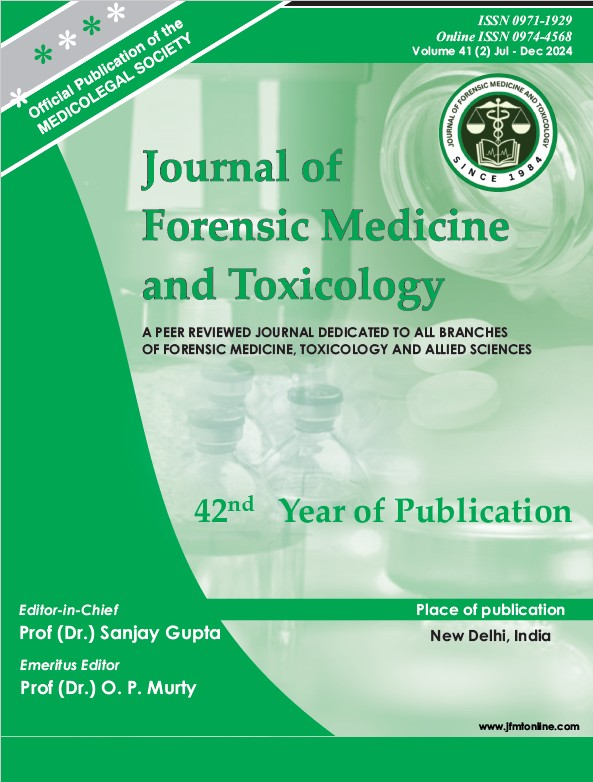Unforeseen occupational injury from textile foil printing machine: A case report exploring injury mechanism and forensic analysis
DOI:
https://doi.org/10.48165/jfmt.2025.42.3.24Keywords:
Foil printing machine, Machine injury, Occupational accident, Health and safety, Hand injuryAbstract
Despite significant efforts to enhance workplace safety, occupational injuries constitute a substantial proportion of the overall injury burden globally. The textile industry is a prominent global industrial sector that utilises a variety of machinery to transform fibres into cloth. This article reports an unusual case in which an injury was caused by a textile hot foil printing machine, a device that is generally regarded as safe. A 40-year-old man suffered severe injury to his upper limb while attempting to introduce fabric into the foil printing machine during the machine’s initial operation time. The injuries are characterised by a combination of abrasion, laceration, crush injury, fracture, and avulsion. The patient was treated surgically, and there was a significant physical and economic burden. Establishing the occurrence and mechanism of injury is essential for raising safety awareness and reducing the likelihood of dangerous injuries among stakeholders. In conclusion, this case report highlights the potential hazards associated with textile hot foil printing machines, despite their apparent level of safety. Heightened awareness, protective measures, and comprehensive training are pivotal to prevent such occupational hazards any industrial settings.
Downloads
References
International Labour Organization (ILO). (n.d.). Occupational safety and health statistics (OSH data base) [Website]. ILOSTAT. Retrieved August 3, 2024, from https://ilostat.ilo.org/methods/concepts-and-defi nitions/description-occupational-safety-and-health-sta tistics/
Gupta, S., Malhotra, A. K., Verma, S. K., & Yadav, R. (2017). In-depth analysis of pattern of occupational injuries and utilization of safety measures among workers of Railway wagon repair workshop in Jhansi (UP). Indian Journal of Occupational and Environmental Medicine, 21(3), 138– 142. https://doi.org/10.4103/ijoem.IJOEM_178_16 3. Abdalla, S., Apramian, S. S., Cantley, L. F., & Cullen, M. R. (2017). Occupation and risk for injuries. In C. N. Mock, R. Nugent, O. Kobusingye, & K. R. Smith (Eds.), Injury prevention and environmental health (3rd ed., pp. 97–109). The International Bank for Reconstruction and Development / The World Bank. Retrieved August 3, 2024, from http://www.ncbi.nlm.nih.gov/books/ NBK525209/
National Crime Records Bureau. (n.d.). Home [Website]. Retrieved August 3, 2024, from https://www.ncrb.gov. in/
Jaiswal, A. (2012). Case control study among carpet thread factory workers in Uttar Pradesh, India: Occupational injury and its deteriorating factors. Global Journal of Human Social Science: History and Anthropology, 12(1), 22–30.
Serinken, M., Türkçüer, İ., Dağlı, B., Karcıoğlu, Ö., Zencir, M., & Uyanık, E. (2012). Work-related injuries in textile industry workers in Turkey. Ulusal Travma ve Acil Cerrahi Dergisi, 18(1), 31–36.
Ganguly, D., & Bansal, T. (2013). Foil printing process on textile material. Textile Trends, 60(7), 41–44.
Martin, N. A., & Falder, S. (2017). A review of the evi dence for threshold of burn injury. Burns, 43(8), 1624– 1639. https://doi.org/10.1016/j.burns.2017.06.013
SuLian. (n.d.). Tips for correctly store hot stamping foil rolls [Website]. Dragon Foils. Retrieved August 5, 2024, from https://www.dragonfoils.com/article/tips-for-cor rectly-store-hot-stamping-foil-rolls.html
Eze, U. O., & Ojifinni, K. A. (2022). Trauma forensics in blunt and sharp force injuries. Journal of the West African College of Surgeons, 12(4), 94–101.
Ministry of Labour & Employment, Government of India. (1923). The Workmen’s Compensation Act, 1923. Retrieved August 5, 2024, from https://labour.gov.in/sites/default/ files/theworkmenact19231.pdfd showing the direction of the wound




